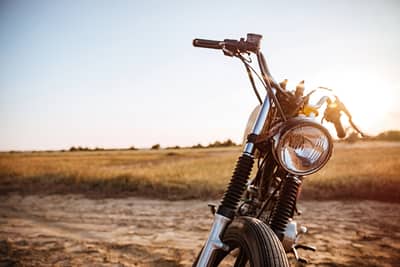A couple of years ago at a big women’s motorcycle festival, a friend of mine laid down her bike and broke off the shifter lever. Bummer. She was fine but her motorcycle was not. The on-site mechanic at the festival tried his best to find a shifter that would work for her bike but to no avail. So, she and a couple of others spent the rest of the day trying to find a motorcycle shop that could fix it. She finally got it fixed, but, she missed an entire day of riding :-(.
Replacing a broken shifter lever is a simple repair job if you have the part. The incident made me think about how we can be more prepared for things like this. So I made a list of some common parts, tools and supplies we can carry on our motorcycles so we can keep our bikes in top riding condition and make simple repairs to get us back on the road.
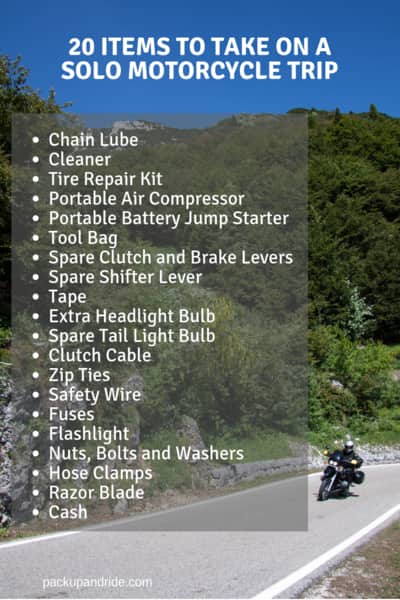
1. Chain Lube
Keeping your chain clean and properly lubed on a multi-day trip will help prevent a roadside breakdown and one that can be dangerous too. So, carry a small can of your favourite chain lube with you. The rule of thumb is to clean and lube your motorcycle chain every 500 – 600 miles. For a typical rider, this would be every other day.
If you’re riding in a dry, dusty environment, give your chain a quick wipe down and lubricate it at the end of each day, even if you don’t cover a lot of miles. The same goes with rainy weather or other wet conditions like water crossings. Water will break down the lubricant faster than usual, so give your wet chain a quick wipe and a lube at the end of the day. Needless to say, a chain cleaning brush and a rag are nice to have items for this job.
2. Cleaner
Carry a small can of all-purpose cleaner that you can use on your plastics, your windscreen and on your helmet visor. Use it nightly to wash the bug guts off your headlight to keep it bright and easy to see. Keep excess dirt off your turn signals and tail lights too. Also, use it to clean your instrument panel and clean your visor often. This will make your ride much safer. I like to carry a micro-fibre towel that I can use on my helmet visor and windscreen, and a separate towel to use on other parts of the bike.
3. Tire Repair Kit
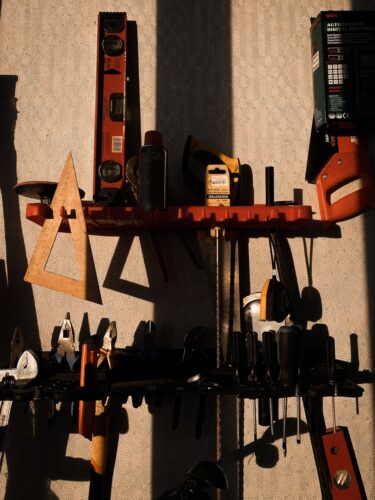
Don’t let a flat tire keep you stranded. If you’re riding on tubeless tires, invest in a good tire puncture repair kit and learn how to use it. Some tire repair kits will include CO2 cartridges used to inflate your tire enough to get you to a gas station or somewhere to properly inflate your tire. You can read my article about riding on a plugged tire here.
4. Portable Air Compressor
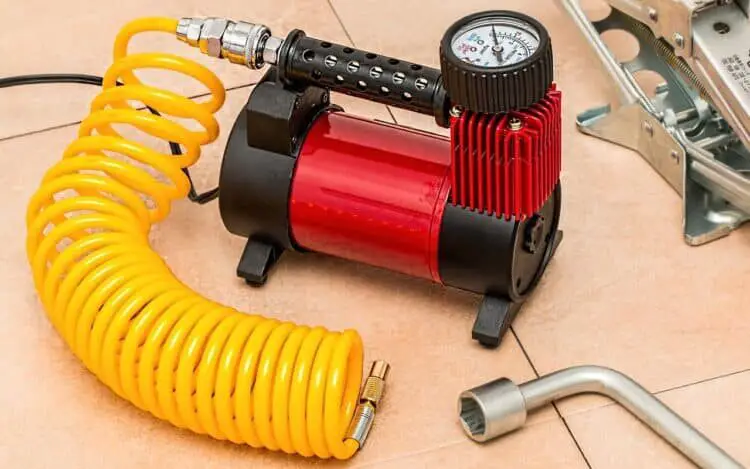
Instead of relying on CO2 cartridges to inflate your tire, it’s a good idea to pack a portable air compressor like this one (check the Amazon price). It is strong enough to inflate your tire to 40 psi. With an air compressor, you’ll be sure to have air whenever you need it. If you rely on cartridges, you could use them all, then you’re stuck with nothing. A compressor is also handy for inflating your tire back up when transitioning from dirt riding, back to pavement.
Oh, by the way, do not use a can of tire inflating fluid, like fix-a-flat, in your motorcycle tire. The liquid will throw off the tire’s balance causing it to wobble at high speeds.
5. Jump Starter or Battery Cables
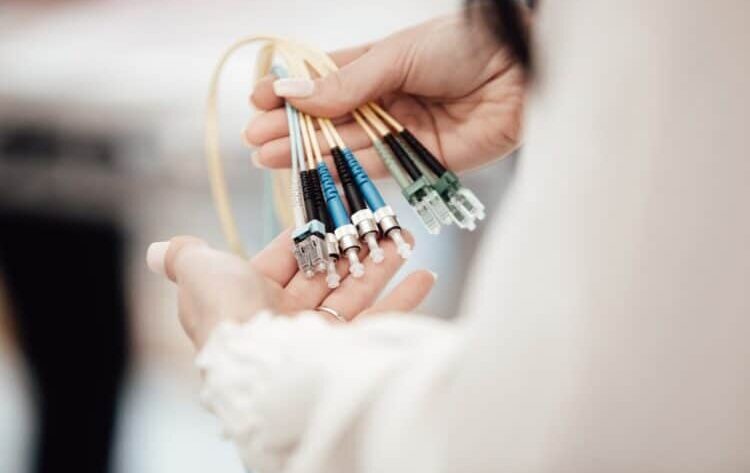
A portable battery jump starter is a very smart roadside repair gadget to pack in your saddle bags. Granted, they can be a bit heavy being a battery, but they can certainly get you out of a pinch if your battery dies. They make handy chargers for your electronics too, like your cell phone, GPS unit or tablet computer. Make sure you keep it fully charged throughout your trip so it will be ready when you need it. Read my review on Portable Jump Starters here.
If you don’t carry a jump starter, consider keeping a small set of jumper cables with you. One of your riding buddies or a good samaritan may be able to provide you with a jump.
6. Tool Roll or Bag
To do minor maintenance and repairs while on a trip will require a thoughtfully put-together set of tools specific to your bike. A lot of motorcycles will come with a few tools like spanners or wrenches, but it’s a good idea to piece together a good set of tools like pliers, Allen wrenches or hex keys, screwdrivers, or any specialty tools that your bike requires. As you read through this list of spare parts, consider what tools you will need to make the repairs on your specific bike. Those are the tools you need in your bag.
7. Spare Levers
Clutch levers and front brake levers are in a vulnerable spot and can be easily bent or broken if you lay down your bike. Carry an extra set of levers that you know will fit on your bike. For these spare parts, you don’t need to go fancy, you just need something that will get you back on the road. I recently put a set of shorty levers on my Honda CB500X, so now I keep my stock levers in my kit as a backup set.
Levers are easy to replace on the roadside and only require a small wrench or two. When you’re putting together your onboard toolkit, make sure you include it.
8. Spare Shifter Lever
Depending on what kind of motorcycle your ride, your shifter lever may be in a vulnerable spot and is a risk of breaking if you dump your motorcycle.
Side note: When I say “dump” your bike, or “laid down” it doesn’t necessarily refer to a crash. Inexperienced riders can get caught by surprise when riding super slow through gravel, or you could have a foot slip out from under you. Sometimes bikes fall over for no apparent reason. It happens to every rider at least once.
Back to the shifter lever. They can break. So, go out and buy a replacement shifter to include in your tool kit. If your shifter includes a tie rod, consider including that too in case it gets damaged or bent. Make sure you know how to install it and include the necessary wrench size or hex key in your tool roll.
9. Tape
It’s a good idea to carry several different types of tape with you. Duct tape, electrical tape and self-sealing tape. A roll of electrical tape usually isn’t very large so a regular roll will fit in your tool kit without a problem. Duct tape rolls are generally too large to carry so, take a few feet of tape and re-roll it onto a pencil, remove the pencil when you’re done. Now you have a decent length of duct tape handy.
Another good tape to carry is self-sealing tape. This is a silicone tape that does not stick to anything except itself. It’s the perfect tape for repairing a leaking hose. When you apply the tape around the hose, you’ll stretch it tight. The tape will form a seal and will stick to itself. This stuff works great. It can be wound down into a smaller role if you don’t want to carry an entire roll with you.
10. Battery Jump Starter
These days there is no excuse for being stuck with a dead battery. With Lithium Ion battery technology getting better and better, battery jump starters are coming in more compact sizes. Some of them are just larger than cell phones. They usually come with jumper cable clips and hold enough power to start your motorcycle even in cold weather. Some also have features such as USB charging ports to keep your electronics charged. Read my full review of jump starters here.
Make sure you know how to access your battery and that you included the necessary tools in your onboard tool kit.
11. Extra Bulbs
It’s pretty obvious that driving at night without a headlight is a bad idea. But, even in the daytime a burned-out headlight or tail light is a safety issue. Light bulbs can go dead at any time and they don’t give you any warning. That’s why it is a good idea to include bulbs in your repair kit. The type of bulb you use will, of course, depend on your motorcycle, so make sure you purchase bulbs that will fit. It’s a good idea to bring headlight bulbs, tail light and brake lights, and turn indicator bulbs.
For those of you who use low profile, led turn signals, consider including a replacement in your maintenance kit. While they are a little more difficult to replace than a bulb, at least you’ll be safe and on the road again. Like always, know what tools you will need to do the repair. Will you need a small Phillips screwdriver or a hex key? How about a small standard screwdriver to use on the connectors. Pack them with you.
12. Clutch and Throttle Cables
A broken throttle cable equals a dead bike. A broken clutch cable also means you’re not going anywhere. While these types of repairs can be prevented with proper maintenance and pre-ride inspection, sometimes they can take you by surprise. If you have a suspicion that your cables are worn or if they are old and have never been lubed or replaced, consider packing replacements with you.
Cable replacement as a roadside repair is a bit more complicated than, say, changing a bulb, but it can be done. Do some research on your specific motorcycle to learn the steps. Figure out what covers need to be removed to access the cable brackets. Determine what tools you will need to remove those covers. New cables don’t usually come pre-lubricated, so you will need to determine how you will lube the cable before installing it. All of these factors should be considered before your trip.
13. Zip Ties
I have seen the most ingenious repairs done with zip ties or cable ties, and no onboard tool kit should be without them. You don’t need to bring a lot of them, but you do want to carry a variety of different sizes. There are probably a million different ways you can use cable ties, from holding cracked plastics together, to replacing a missing pull tab on your jacket’s zipper. When you’re in the moment and trying to find a solution to a problem, cable ties may give you the perfect temporary solution to get you back on the road.
14. Safety Wire
A foot or two lengths of safety wire can come in handy for a lot of roadside repairs. Safety wire is usually used for securing bolts to a motorcycle so that nothing falls off if it comes loose. This safety feature is mostly used on the track as a loose nut or bolt on the race track presents a hazard for other riders. But, there are a lot of other uses for a bit of safety wire. Use your imagination when in the moment and a small length of wire may be just what you need. Better to have it than to not have it.
15. Fuses
Carry at least one type of fuse for each type used on your motorcycle. Check your owner’s manual to see what size and what amps are needed. Replacement fuses are available at your local motorcycle shop or auto parts store and often come in a set in a handy little carrying case.
But, having the fuses with you is only part of this repair solution. Make sure you know where the fuse box is located on your motorcycle. Check the owner’s manual or shop manual to locate other fuses that aren’t at the fuse box. If you have after-market auxiliary lights or plugs installed on your bike, make sure you bring fuses rated for those items as well.
16. Flashlight
Doing maintenance or repairs on your bike, even during the light of day, will sometimes be much easier if you have a light to shine in those little small spaces. If you’re camping, then you probably already have a headlamp for a flashlight that you can use. But, you might not always have your camping gear with you on a day ride. Keep a small flashlight in your tool kit and make sure the batteries are fresh before you leave on your trip.
17. Nuts, Bolts and Washers
Keeping a couple of extra common bolts and nuts that fit various parts of your motorcycle would make a great addition to your tool kit. When doing roadside repair or maintenance during your trip, nuts and bolts can get lost, broken and, if not properly torqued, some bolts could work their way loose during a ride.
18. Hose Clamps
A variety of hose clamp sizes will be a good addition to your maintenance kit. Pack the stainless steel variety that screws tight and the smaller variety that is self-tensioning. A spare hose clamp will save you a lot of headaches if you need to repair a fuel line or radiator hose (if you have one).
19. Razor Blade
Consider keeping a small razor-sharp blade in your tool kit. A compact retractable box cutter will do. They are perfect for cutting bits of tape, hose, tubing or a package of freeze-dried beef stroganoff for your dinner. Whatever you use it for, it’s a handy item to have around. They are inexpensive and readily available at any dollar store.
20. Cash
Right now, I could go out to the garage, take the seat off my motorcycle, get into the little zip lock baggie where I keep my registration and find a $20 bill. I put it in there a long time ago and forgot about it. But, having it there could get me out of a pinch someday. Even in this day of ATMs and credit cards, there are still out-of-the-way places, little mom-and-pop shops that only take cash.
While some of the items on this list will help you keep your motorcycle well maintained during your trip, other items will help you make roadside repairs so that you can keep riding. Remember, if your repair is an emergency fix for a bigger problem, take your bike to the nearest repair shop and get a permanent fix before you continue on your journey. I hope this list has helped you determine what to include in your roadside motorcycle repair kit.
Conclusion
Other than professional mechanics, you can also use tool kits for regular maintenance of your Harley Davidson or any other bikes in less time. Motorcycle tools help to extend the long life of a bike for smooth and safe rides.
Glance through a wide range of tool kits for your for all types of vehicles and get the appropriate tool chest for your Harley Davidson motorcycles.

